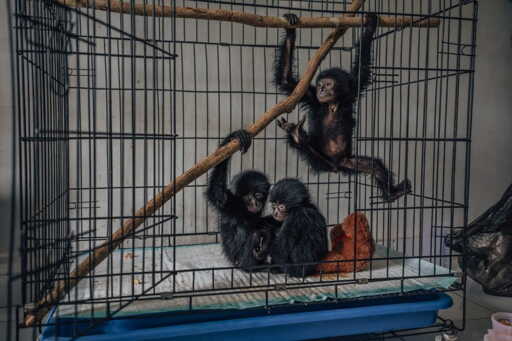MEDAN, Indonesia — Two infant siamang gibbons cling to each other. Barely 6 months old, their lanky limbs entwine their tiny bodies as they stare out of the triage cage, their wide eyes shining. Each is an orphaned victim of the illegal pet trade. Like most trafficked gibbons, their mothers were likely shot and killed by poachers before they were wrested from her body and shipped into the trade. Deprived of maternal body heat and milk, the youngsters now instinctively grip each other as if for comfort. At the back of the rescue enclosure, a smaller body hunkers in a corner, shrouded in solitude and silence. A tiny Javan gibbon, it glances up from time to time, but is wary. “The Javan gibbon is still shy,” says Sinan Serhadli, support officer at the gibbon rehabilitation and release program run by the Orangutan Information Centre (OIC) as part of the Sumatran Rescue Alliance (SRA) in Indonesia’s North Sumatra province. “He will eat, but he doesn’t want any contact with humans.” Sinan Serhadli inspects the health of two siamang gibbons that were confiscated from traffickers in March 2025. Image by Carolyn Cowan / Mongabay. The infant siamangs (Symphalangus syndactylus) and Javan gibbon (Hylobates moloch) were brought to the SRA rehabilitation center on the outskirts of Gunung Leuser National Park in March 2025 after an Indonesian naval patrol confiscated them from a boat intercepted in the Strait of Malacca. The vessel, believed to be destined for Peninsular Malaysia or southern Thailand, was smuggling…This article was originally published on Mongabay
From Conservation news via this RSS feed


